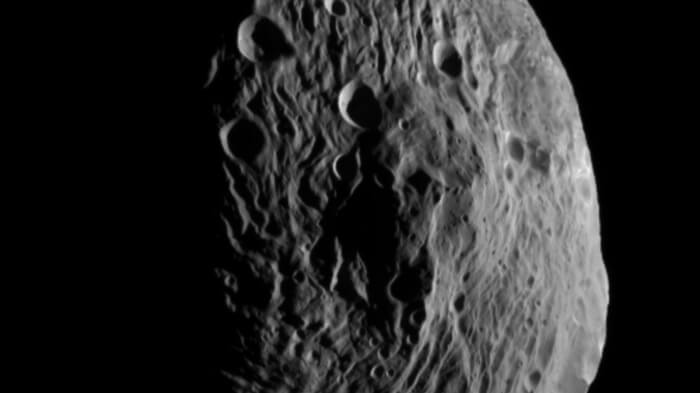The DAWN spacecraft transmitted the first high-quality images of the asteroid Vesta, which recently began orbiting

The clear difference between day and night stands out in a new image of the asteroid Vesta, taken by the Dawn spacecraft, which is currently orbiting the asteroid.
Dawn photographed Vesta on July 18 from a distance of about 10,500 km, when it passed over Vesta's terminator line. The terminator is the boundary between day and night on the sky.
This image shows a large trajectory near the south pole of Vesta. This trajectory was also seen in earlier images taken by Dawn, and here it is seen in the center of Vesta's bright region.
This image shows the shadowed surface of Vesta in greater detail than was seen in the image released on July 18. The asteroid rotates on its axis too in five hours and 20 minutes, according to scientists.
The Dawn mission entered orbit around Vesta on July 15. The diameter of Vesta is 530 km, and it is the second largest asteroid in the asteroid belt between Jupiter and Jupiter. It is also the brightest asteroid in the solar system
Dawn is expected to continue photographing Vesta, exploring the giant space rock from three different orbits. Due to the relatively large size of Vesta, astronomers define it as a protoplanet, and say that the "mess" that Jupiter and Mars made in the asteroid belt, Vesta would have long ago become a planet with a diameter similar to Earth.
The Dawn mission costs NASA 466 million dollars, and is the first mission that includes a long-term visit to an asteroid. After a year in orbit around Vesta, Dawn will continue to visit the 950 km diameter asteroid Ceres. Ceres is the largest body in the asteroid belt, and is so large that it is considered to be a dwarf planet.
Dawn is expected to reveal the surface of Ceres in great detail, so that it can be compared with the more developed surface of Vesta. It is assumed that Ceres is a more primitive body that probably has ice on it.
Dawn's observations may help scientists better understand the early days of the solar system, as well as the process of formation of rocky bodies like Earth.
The Dawn spacecraft was launched in September 2007 and travels in space over 2.7 billion km.

6 תגובות
Thank you …
But I already understood after some calculations that with the Earth on the opposite side it is about 150 million one unit
And the ephelion of Mars is about 250 million, which is more than one and a half units, so it comes out to more than two and a half units, about 2 million!
I have another question, is it possible to see Jupiter at 3-4 in the morning because I saw a bright star in the center of the sky a little to the south...
I would love to hear an answer regarding justice!
You are really confused
We are talking about the distance between Earth and Mars!
When they are very close, meaning they are both on the same side of the sun, the distance between them is about half an astronomical unit and can even reach forty percent due to the elliptical shape of their orbits.
But when they are at a distance opposite to the sun, then the distance is 1+1.5 = 2.5 astronomical units. The average between half and two and a half is one and a half.
And in addition, the flight path is not a straight line but a curved line. They say that a flight to Mars will take half a year in each direction with about half a year on Mars itself.
I hope this is understandable now
Sabdarmish Yehuda
The Israeli Astronomical Society.
I was even more confused if the distance from Earth to Mars is half an astronomical unit to 2 and a half
2 and a half times an astronomical unit from an age of about 650 million kilometers and there it is already justice!
And he asked if it is possible to see Tzedek these days at 3-4 in the morning a little above us on the south side
Because I saw a bright star and according to the star map it is justice, it makes sense
I would love to hear answers because I am quite new to astronomy...
To anonymous
Some inaccuracies.
Mars is one and a half astronomical units away from the sun, while the Earth is one unit, so the distance between the two aforementioned planets is roughly, from half a unit to two and a half units, so the average distance is 1.5 astronomical units, which is approximately 225 million km. Actually the ranges are more extreme because of the elliptical orbits of the planets.
The speed of the spacecraft moving away from the Earth is slowing down because of the Earth's gravity, so it is not correct to take the known speed of the shuttle for the entire length of the orbit. Only towards the end of the journey does the target's gravity increase over that of the Earth and the spacecraft accelerates.
third. It is clear to you that the shuttle is not the one that will go to the moon or Mars, but a different type of spacecraft.
Have a nice flight
Sabdarmish Yehuda
The Israeli Astronomical Society
Hello, I have a question... how long will it take to reach Mars?
After all, the distance is about 78 million kilometers on average and can even reach around 56 million
And the speed of a space shuttle is about 28-29 thousand kilometers according to this calculation
I got 4 months and the moon is less than 15 hours, does that make sense??
And how long is a flight to the moon two and a half days???
I'd love to hear answers
Are there more technical details about the asteroid?
What does it basically consist of, metallic content and so on?